Saab loyalists flock to Sturgis, keeping passion for the brand alive

Saab enthusiasts know something the rest of us don’t.
That has to be it, right? Every Saabist I interviewed at the 2022 Saab Owner’s Convention (SOC) sparkled with the same twinkle in their eye, cracking the a knowing smile each time I led with the question:
Why Saab?
The particulars of their answers differed. “Oh, my brother’s friend had one, and I bought it from him.” Or, “I drove a cheap old 96 in college.” But soon enough, the veneer of circumstance wore thin, and the shared soul of these obsessives shone through:
There’s nothing else like it.
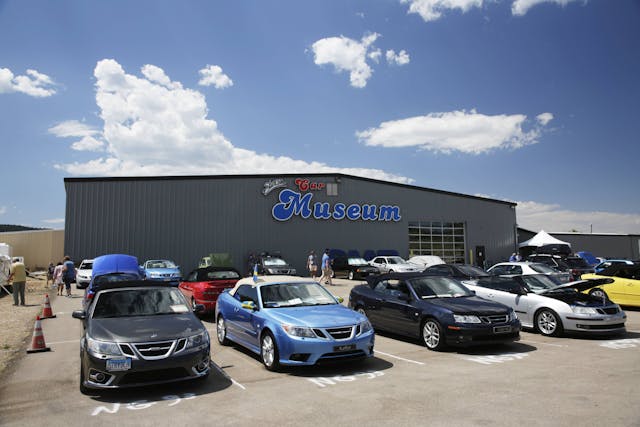
Ten years out from the Swedish automaker’s painful demise, the heart of the Saab community beats louder and stronger than it had in the decade prior to the brand’s death. This past July, over 500 enthusiasts from 31 states and five countries converged in Sturgis, South Dakota, just a week-and-a-half before the city’s famous motorcycle rally. Sixty percent of attendees were first-timers to the event.
That’s a big boost, but we’re not entirely surprised. According to our data, quote volume and average quote value for Saabs are both up 25 percent from the summer of 2020, attention no-doubt buoyed by splashy big-money Bring a Trailer sales of clean, low-mileage 900 SPGs. The 900 Turbo’s inclusion on our 2023 Bull Market roster is no happy accident. Interest in the defunct marque, it would seem, has only mounted in the past decade.
Much like the cars themselves, Saab’s surging attention either makes total sense or comes off a bit weird, depending on one’s perspective. Remember: Saab always did things differently, and distinction attracts dedication. In its heyday, the Swedish automaker claimed legions of counter-culture loyalists. The brand’s innovative and sometimes eccentric approach to automotive ergonomics and engineering stoked the fires of the Saab Spirit—that intangible otherness that sets its claws deep.
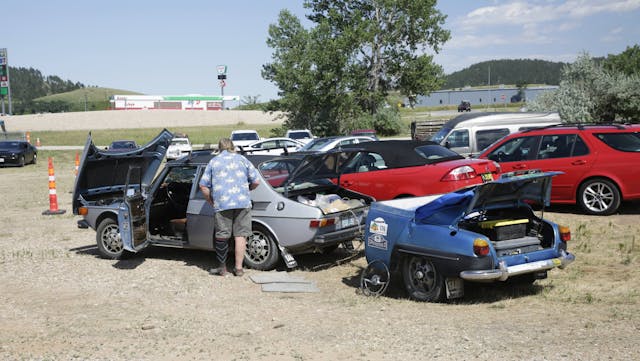
Outsiders often label Saab’s many unconventionalities as “quirky.”
“I got that a lot during interviews in my first year,” says Tim Colbeck, after an audible sigh. “Quirky is just a less-flattering way to say interesting, right?” Colbeck was the President and COO of Saab North America from 2011 until 2013, and he is now the President and CEO of Saab Parts North America and parent company Orio’s North American operations. “They’re different, they’re interesting, they’re engaging. I think [those are] are the things that make connections, versus things that are simply boring and dependable.”
Colbeck, also a longtime sales exec at Subaru, arrived at Saab in the second year of its separation from General Motors. “It was the blank slate and starting anew that really had us excited,” he remembers. We’re chatting inside Sturgis’s Saab Heritage Museum, where an original one-of-six Saab Sonett I, purchased from the GM Heritage Collection, sits four feet away. “We had very little turnover employees. The suppliers pretty much stayed intact the whole time. It felt like we were all pulling together, but that September, it all fell apart,” explains Colbeck. “That period involved some of the most fun and challenging times I’ve ever had in my career, and I’ve been in the automotive business for 36 years.”

Colbeck confirms that, despite a dousing from GM accountants and a bankruptcy, the “Saab Spirit” was still burning right up though the end. “My very first day with a group of Saab engineers [in Sweden], I walked through this reception, meeting as many of them as I could, and asking them what makes a Saab a Saab,” he recounts. “They said, ‘Everything that’s designed in a Saab is designed around the driver. The car is an extension of the driver.’”
Another enthusiast and SOC event organizer apologetically interrupts my conversation with Colbeck. He’s a popular guy around here. I asked her my keystone question of Why Saab? She laughs. “Have you ever driven a Saab? Once you do, you’re stuck,” she says. “It’s all about the turbo—everything else just crawls. I can’t think of another brand I would drive.”
Why not a modern BMW or equivalent, I suggest. Practically every late-model 3 or 5 Series comes with forced induction. She waves this suggestion away. “It’s a lifestyle more than anything else. You just get that bug. It stops being about the cars. Last night at the group dinner, everyone stopped the presentation and sang happy birthday to me. It becomes a family.”
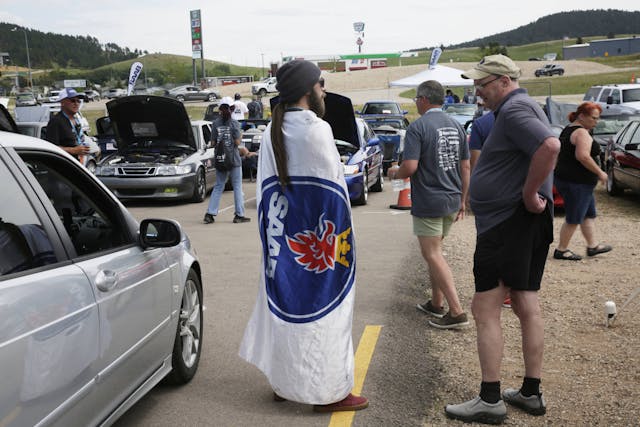
Never have I attended an automotive event at which the cars matter so little. Months later, I remember the colorful band of devoted enthusiasts far more than any of the hundreds of Saabs in attendance. “The personality engages the crowd,” observes Colbeck. “A lot of these folks have been connected to these cars for years. Every one of these cars has a story. It’s the emotional connection.”
I walk around the Heritage Museum floor, reading windshield placards stuck to around 110 Saabs of all shapes, sizes, colors, ages, and conditions. Some of the cars would be remarkable in any context: the aforementioned Sonett I, an assortment of fabulously clean 92s, and a 900 SPG that GM restored from the lugs up. Filling in the gaps are weatherworn examples of workaday Saabs, each with a story to tell.
“The majority of the museum cars are used,” says museum founder Tom Donney. “Used cars have patina. They have character. When you go to the [Saab] museum in Sweden, all the cars are brand-new. The Swedes who visit here all love it. It’s the stories that captivate. If you’re a normal person walking in, it’s not the cars that will interest you—it’s the stories.”

According to the window sticker on a red 900, the museum refers to it as the “loaf of bread car,” so-named after the original buyer negotiated a good deal contingent on delivering a loaf of her “famous” bread to the dealer. Toward the front of the museum, signage on a dark red 1958 93B recounts the car’s speedy escape from a house fire. A blue 9-3 Viggen was restored by a well-known independent Saab shop after a father and son hit a deer. A 9000 once served as an unlikely cop car in Aspen, Colorado.
Donney, who prior to his museum life established a highly successful transmission rebuilding business out of Fort Dodge, Iowa, sits down with me in his small apartment located in the back of the museum’s workshop. Just outside, on the shop floor, visitors pick through a pop-up flea market of Saab parts and memorabilia. I ask him about the museum’s staff. “You’re looking at the full-time mechanic, the full-time janitor, the full-time car salesman, the full time tire-pumper, the full time ad-guy,” he explains. It sounds exhausting.
Donney, much like Colbeck, is a pillar of the Saab enthusiast community. At the previous night’s group dinner he gave a rousing and emotional speech on the state, financials, and logistics of the museum. “This is not my museum,” he told the hundreds-strong crowd. “This is your museum. This is our museum.” He encouraged attendees to “Catch the Dream,” and to take responsibility for the museum into the community’s hands. One person came on stage and donated $5000. A few minutes later, the winner of the event’s raffle donated the winnings back to the museum.

Donney is adamant that a the museum needs to think about sustainability if it wants to endure long-term. “I don’t want this place to fold when I’m gone,” he says.
And where would the cars go? Saab conventions are usually held in locations of high Saab concentration, and Donney is probably one of very few Saab owners this side of Rapid City. Perhaps fittingly, South Dakota is an eccentric location to house the U.S.’ preeminent collection of Swedish cars.
How it ended up there is equally unexpected. As a former football coach at the Black Hills State University in Spearfish, South Dakota, Donney would make seasonal trips from Iowa out to the area, about 25 minutes from Sturgis. “I’d always bring a couple vintage cars with me,” he explains. “I’d leave them behind in the fall, and when I came back in the spring, they’d be identical to when I left them. I did some research on fine art; most of it is stored in around 35 percent humidity, and this region runs at that humidity. It makes for a really nice place to preserve stuff.”

Donney drove his first car, a hand-me-down 1963 Saab GT, throughout high school. He still owns it, though it sits in a state of disrepair in the workshop. The driver’s seat is a patchwork of patterned cloth—his mother’s handiwork from way, way back when. The car will soon benefit from sympathetic restoration.
That first toe in the waters of Saab mania was a rather pragmatic dip. “The GT was economical, reliable, and cheap to fix, and I could fix it myself. It got 35, 40 mpg. All my buddies were all driving big muscle cars. It was what I could afford,” he explains. Then, a smile. “I’m half Swedish, but I don’t think that has any connection. Unless there’s something in my DNA.”
Around a hundred Saabs followed Donney’s first GT, which isn’t as fundamentally outrageous as it sounds. Multi-Saab ownership is apparently a ubiquitous element of the passion. Literally every single owner I talk to at the SOC has more than one Saab. Some have two, others six, and many more boast Saab fleets numbering in the teens. One enthusiast in his young twenties got the bug from his father, who owned fifteen Saabs at one point. Another young owner chimes to tell me he’s on his third Saab: “I’m 17 and just getting started.”
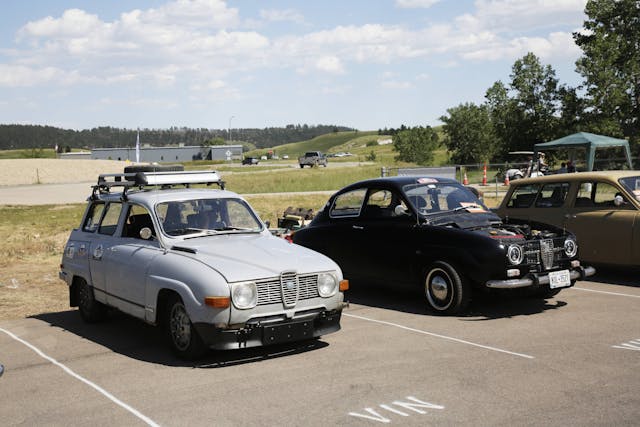
It was a demographic potpourri that came to South Dakota for the SOC. A slim majority are baby boomer-aged or older, but a healthy portion are under 40. A fair number of women owners attended as well, in what seemed like a larger ratio compared to other marque-specific events. The club is growing, and it’s getting younger every year. Teenagers made the pilgrimage to meet Jacob Pretzman of the popular (and Saab-centric) Auto Autopsy YouTube channel; as one of the leading young voices in the community, Pretzman won the club’s Young Enthusiast Award a few years back.
The Saabs themselves are as varied as their owners. One might expect that the majority of the die-hards willing to make the trek to Sturgis are hardcore two-stroke snobs who spit premix at anything newer than a 95, or turbo evangelists who live and breathe the 900. Yet the later, GM-era 9-3s and 9-5s showed up in the greatest numbers. “The community used to be pretty divided between the very clean restored cars and the newer modified cars,” clarifies Saab Club of North America President Sandy Bogage. “We had to work as a club to bring both sides together.”
Bogage tells me of another young Saabist who developed a fix for the finicky navigation systems in later-model cars and, at the SOC, set up shop in the hotel parking lot one night to update a few cars with his laptop. “Even with Orio’s big catalog of new parts, there’s no way you can keep these cars on the road without [owners] helping each other. So, the club grows,” says Bogage.
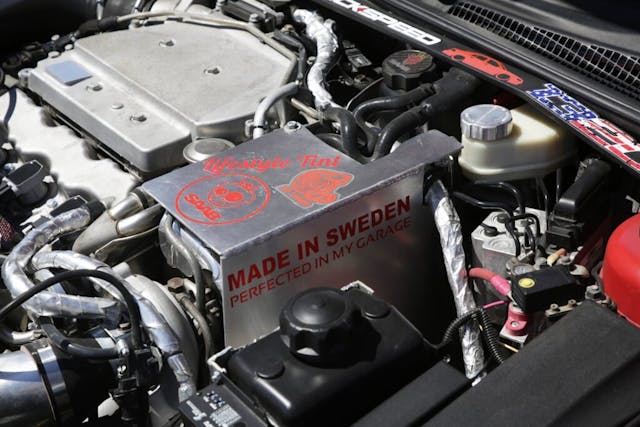
Dinners have a communal feel. Known personalities from the Saab community come up on the banquet hall’s stage and discuss cars, club affairs, show videos, and host trivia. After receiving a round of cheers and excited whispers at the announcement of new part availability at Orio, Colbeck gives a presentation on his trip to Trollhättan, Sweden, for the brand’s 75th-anniversary gathering just one month prior. Between slides filled with UrSaabs and minty 93s, a picture of a Saab covered in Smurf graphics elicits laughs. Nobody boos.
Finally, some awards. And what do you think won Best-in-Show? A modified and louvered 99 Turbo? A preserved 92? Maybe a SEMA-ready Viggen? Nej. Doug Crane’s wrapper-fresh, bone-stock 2010 9-3X wagon took home the gold.
Saab really did capture something, right up until the end. One look around today—the cladding, the ubiquitous crossovers—the joyless interiors—underscores how the automotive industry has shed bold personality in the favor of safe homogeneity. There are exceptions, like the Hyundai Ioniq 5, and it makes one wonder. If independent Saab had survived to tackle today’s electrification craze, some of that “Saab Spirit” injected into the EV space would stave off what many fear is an appliance-filled future.
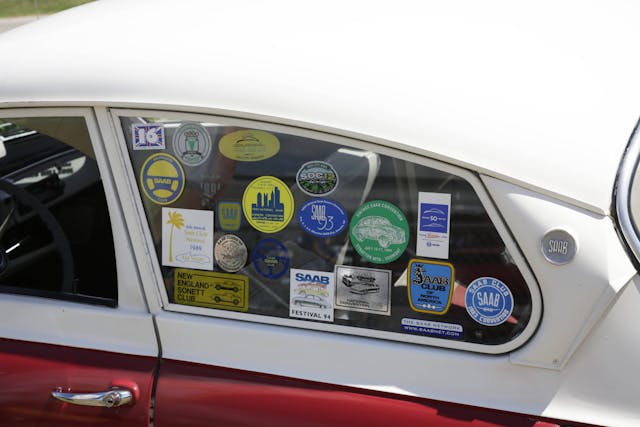
Colbeck points out that Subaru, Volvo, and Audi picked up Saab’s stranded customer base, now scattered. It’s sad, really. He tells me of the period in December and January at the end of 2011, when the company was restructuring; various owners groups around the nation held “SAVE SAAB” rallies
“There was this sense of connection with the brand that was pretty remarkable. It continues to exist today, a decade after the brand ceases to exist,” he said.
“We all feel like we’re keeping a legacy going.”

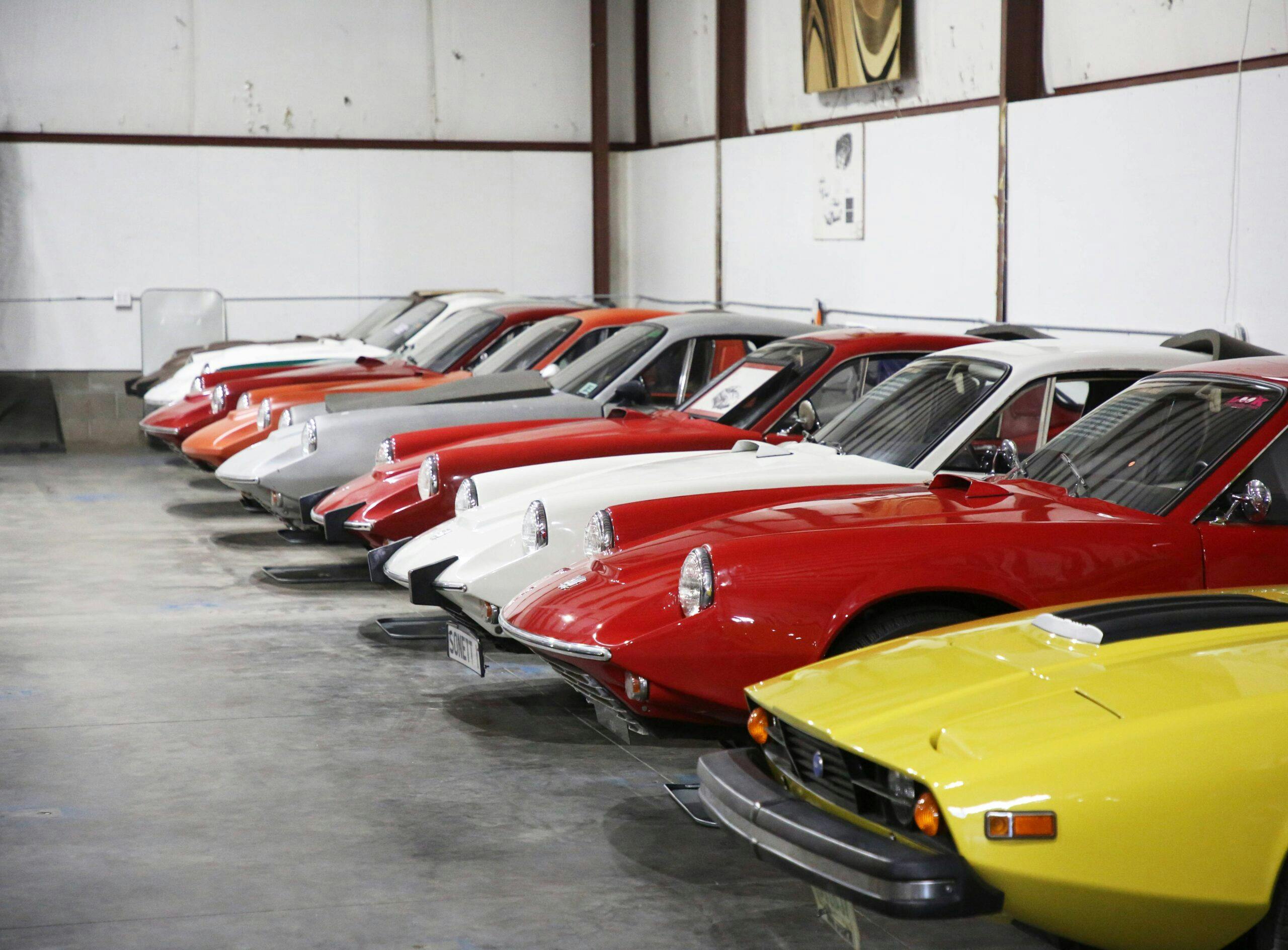

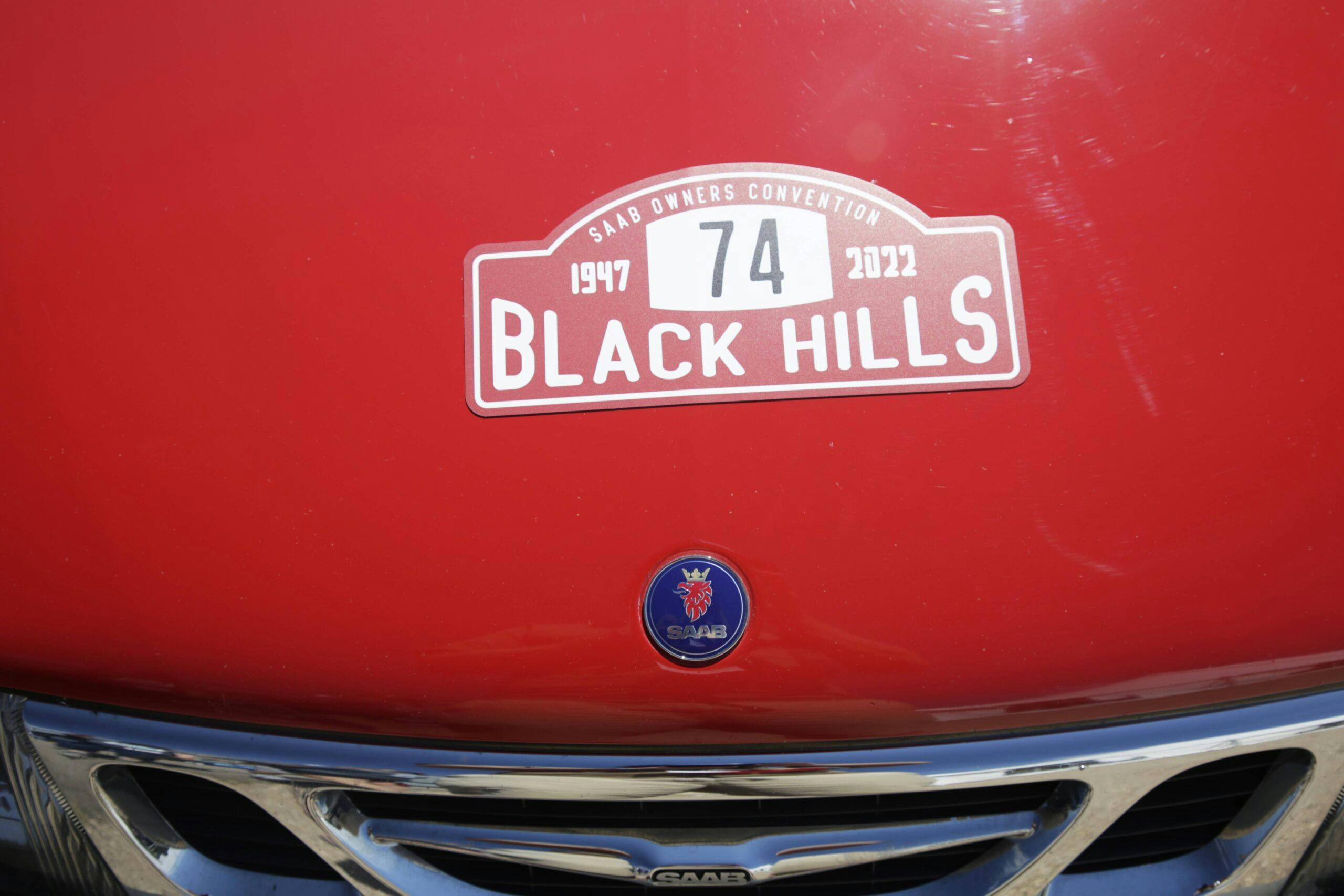


Studebaker people can relate.
Hagerty insures classic cars. Saabs are all getting past the usual age range of daily driver commuter life… makes sense that more of them will be held and saved now?
They look different (always have) and have that “your in the club” thing that few things below high-end do.
My Hagerty-insured 9000 is hiding in the back of the picture with the Monte Carlo Yellow C900 convertible. In fact, I switched to them for the drive to Sturgis for MA; I wanted better roadside assistance coverage than what my prior carrier provided. I didn’t use it, all the credit to my SAAB specialist mechanic…
Love to see a SAAB enthusiast article! I take pride in being (probably) the youngest member of the SaabCentral forum page. I have a 2004 5-speed 9-3 I got in January 2022 and I spent the year working on it. I’ve had an appreciation for SAAB since I was around 8. Something about the clear taillights on a 9-3 Sportcombi I saw fascinated me. Finally at 15 I got my own and began to learn about how to work on cars. My appreciation grew as I learned how fascinating the engineering is behind a SAAB. I will be turning 16 soon and getting a license. I couldn’t be more glad to have a SAAB as a first car to have fun with in the very near future.
I love this! Great post. Keep that enthusiasm- it’s priceless. Please know that you are joining a legion of Saab owners that very much understand. It took me a bit longer to find the brand, but after 15 years of Saab ownership, I can say they’re worth it!
Great to see younger folks appreciating the excellent engineering and quirkiness of SAAB’s. Also glad you know it’s a SAAB and not a Saab.
Less than two years ago I owned four SAABs; a 2008 9-5 Aero sedan, a 2006 9-3SC (wagon), a 2000 Viggen ‘vert, and a 1964 Quantum IV formula S racer. Alas, the need for a low mileage long distance cruiser necessitated sale of the 9-5 with 215K miles. Lack of opportunities to drive the Viggen in Michigan’s weather, coupled with rapidly rising market value, resulted in sale of the convertible with only 84K miles. My wife has no intention of ever releasing ownership of her 9-3SC, and the profits from the Viggen sale are being devoted to restoration of the Quantum IV, chassis number 9.
Thank you for this article, Hagerty. It reminds me of the spirit shown in the “Farewell to SAAB” segment from Top Gear (UK). There IS something very different about SAAB.
Our family got into SAABs in the early to mid 2000’s after years of admiration. We still have two survivors- my parents have a 2005 9-3 2 OT convertible, and I still have my 2008 9-3 2 OT convertible, ironically both in nocturne blue. They aren’t going anywhere any time soon! At one point, we had four between my sister, parents, and me.
My SAABs are like a trusted friend. My fist SAAB, a 2006 9-3 2 OT, inspired me to buy my first house (I couldn’t condemn it to a muni parking lot like my previous cars). My second SAAB, my current SAAB, bought in 2010, brought our firstborn home from the hospital years later when she was born (my knees were on the dash because of the baby seat in the back!). Our neighbors bet we would sell with a new baby, since my husband had a Cadillac coupe. Oh no. We just leased our first Cadillac SUV, which lived in the driveway with the convertible safely inside!
I’ve often joked that one day, I’ll teach our daughters how to drive my SAAB (they are 5 and 7 now). Now, they love riding in it with the top down on a summer day. I love driving with them in the back on what is often a girls’ fun day. It’s truly a car that has brought joy and happiness to my family and I at every phase of life, and I don’t see that changing. I may not drive it everyday like I used to (my daily driver is a 2020 XT5), but when I do, I almost always say, “I love this car” out loud when I do. It may not be as modern as what I’m used to, but I don’t care. I cherish my SAAB, and many have commented that is still looks new.
I’m so glad to see that I’m not alone in my passion for this brand!
Cool group of cars. I still wish GM had not gotten a hold of Saab.
Visited this museum a year ago fall. Took my wife and another couple. We were the only ones there and got the Royal Swedish treatment. First thing walking in I said, “hey it’s all SAABs” and our tour guide asked would you have come if you had known that ahead of time? I said I would have but I can’t speak for THEM. He made our visit so much fun everyone talked about if for days. We will definitely return on our next trip through the area.
Still have 2 of the 3 SAABs I have owned, a ’66 96 2-stroke and a ’68 Sonett V4. Sold the ’69 96 V4 to a friend-in -need. Love the SAAB family, but couldn’t afford to attend the convention in Sturgis this year (I have attended over a dozen over the years). Happy to see young people interested in older SAABs, but not so happy to see that their increasing prices are keeping them out of the hands of enthusiasts.
Incredible response site on the “The SAFEST Car in the WORLD !